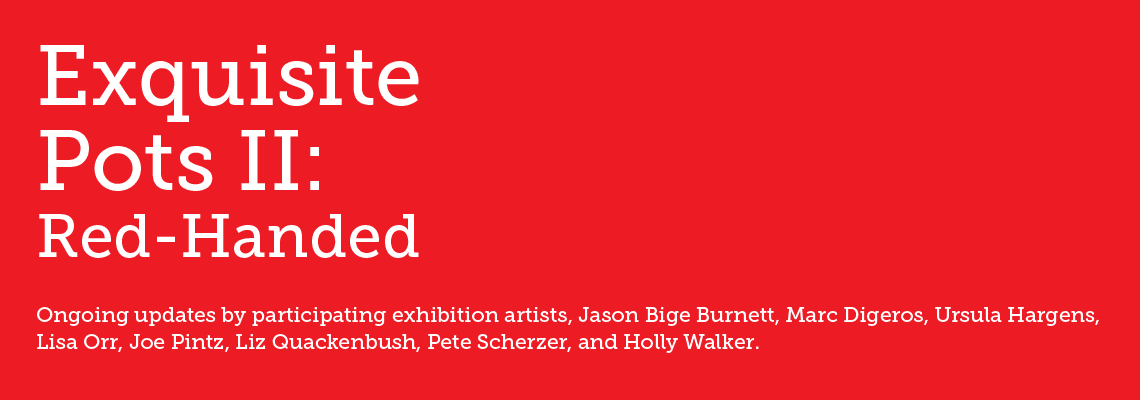Holly Walker:
Q2: If you've had other collaborative experiences, how does this experience differ so far? If not, what were some preconceptions you had and how have they held up? My collaborative experiences in the past have mostly happened in shared time with wet work- my collaborators and I have been working in the same room, having conversations as we respond to what has just been built and handed over for exploration. Responding to a bisqued surprise form which I had no input on is a totally different challenge. As I have gathered the arriving work, I've been surprised with the delicacy and weightlessness of many of the pots. I'm so accustomed to the solidity and weight of my own pinched coil work. I wonder- are everyone else's fingers thinner, more tapered, less muscular than mine? In two days, I will set all the work before me and try to envision each piece.
Pete Sherzer:
Q1: It is early in the collaborative process, but what technical challenges have you encountered working with another makers forms/clays/glazes? I haven't had any significant technical challenges yet. At this point, I have received most of the work from the other artists and fired tests to make sure my glazes will work on the different clay bodies. I have also spent a lot of time staring at the pots, trying to figure out what to do with them. I make my work with specific glazes in mind. The shapes, edges and textures on a piece all change the way a glaze behaves. The challenge with this work is to finish it successfully without being involved in the process up until now.
Q2: If you've had other collaborative experiences, how does this experience differ so far? If not, what were some preconceptions you had and how have they held up? I've never intentionally collaborated with other artists, but ceramics has a collaborative element. Wood kilns can't, or at least shouldn't, be done by one person. Studios are almost always shared, and large projects are often executed with assistants or employees. This project is interesting because its so clearly defined. In some ways it feels like a solo project, I have to figure out how to glaze specific pieces provided by other artists.
*Note: a video of Pete working in his studio can be seen at https://vimeo.com/65441042
Jason Bige Burnett:
Q2: If you've had other collaborative
experiences, how does this experience differ so far? If not, what were some
preconceptions you had and how have they held up? I collaborated with the illustrator/printmaker Eleanor
Annand back in 2011 while we were Core Fellowship students at
Penland School of Crafts. It was helpful that we lived together and worked in
such close proximity. We shared interests in nautical themes and played off of
that. The highlight was that we were in a place that financially we could
afford to make work that was true to its price and we could split the artist
percentage of sales. See some of the work we created together below:
Collaborating with the artists of Exquisite Pots II: Red-Handed I'm very intimidated on so many
levels (however very excited). These are artists I used to write papers on
while I was an undergraduate student. It's surreal. This experience has been
enriching on many levels. First, making the work without decorating it has
allowed me to focus more on form and understand the construction process more.
My work forces me to work slowly because of the decoration process that
primarily happens at leather hard and my attention draws primarily to the
surface treatments. Now, I'm starting to think more about form and creating
vessels that push these surfaces and the techniques.
Second, I'm not only working with one artist who I communicate
with on a daily basis, but instead with artists who have busy lives as studio
artists and professors, are in different time zones, and more. Communication
through e-mails and phone calls has been good, but it’s important to know
exactly what to communicate while having them on the phone. For example being
able to express concerns of glaze fit and more. In fact I'm running several
different bisque temp firings for the artists because I want to lessen any
chances of fit issues. Finally, having the opportunity to work with these
artists I feel is the most honest opportunity to have an education in being a
studio artist. I'm looking forward to hearing from them ways my work could
improve, and how their decisions and choices can better influence or educate my
own. Plus, by decorating their surfaces it challenges my visual vocabulary and
decoration methods simply by taking me out of my own comfort zone.
When working with Eleanor we were friends, roommates,
and made work over shared and similar backgrounds. Now, I'm working with seven
artists; three that I've met it small increments of time, and four that I'd
never met before in my life until talking to them on the phone.
I won't be able to do a lot of screen print transfers and that's been
somewhat of a downer, but to have the work arrive glazed and live with it in my
studio, looking at it, and analyzing how to decorate it has been extremely
rewarding. Personally its neat to think that the work they have sent is
complete, but the understanding that it's not finished excites me. The
challenge here is how do I decorate it while keeping its original integrity.
Essentially, how do I compliment what they've already done? It's exactly what
we're doing by decorating the bisque work; I just have different information
provided in front of me.
